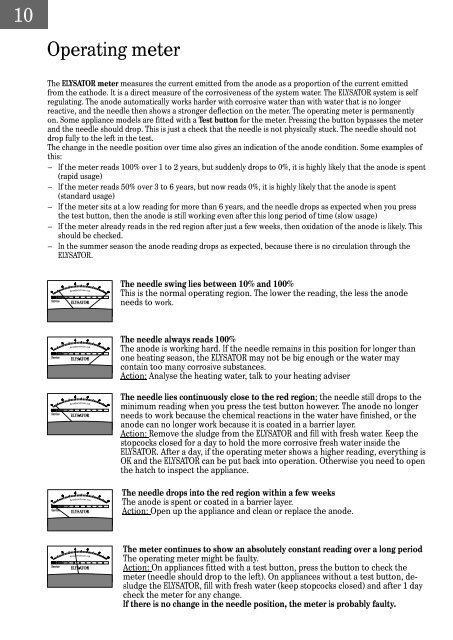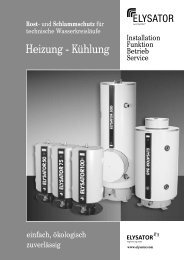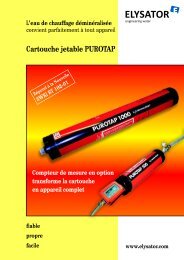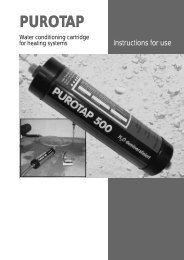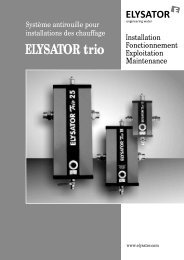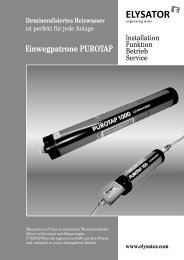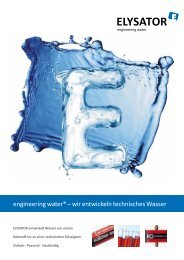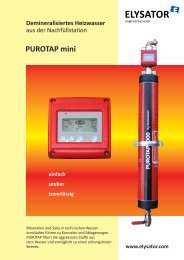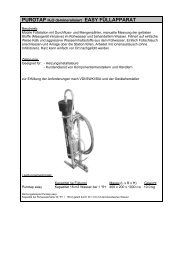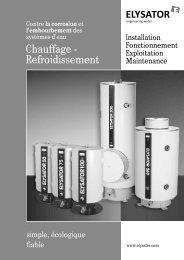You also want an ePaper? Increase the reach of your titles
YUMPU automatically turns print PDFs into web optimized ePapers that Google loves.
10<br />
Operating meter<br />
The ELYSATOR meter measures the current emitted from the anode as a proportion of the current emitted<br />
from the cathode. It is a direct measure of the corrosiveness of the system water. The ELYSATOR system is self<br />
regulating. The anode automatically works harder with corrosive water than with water that is no longer<br />
reactive, and the needle then shows a stronger deflection on the meter. The operating meter is permanently<br />
on. Some appliance models are fitted with a Test button for the meter. Pressing the button bypasses the meter<br />
and the needle should drop. This is just a check that the needle is not physically stuck. The needle should not<br />
drop fully to the left in the test.<br />
The change in the needle position over time also gives an indication of the anode condition. Some examples of<br />
this:<br />
– If the meter reads 100% over 1 to 2 years, but suddenly drops to 0%, it is highly likely that the anode is spent<br />
(rapid usage)<br />
– If the meter reads 50% over 3 to 6 years, but now reads 0%, it is highly likely that the anode is spent<br />
(standard usage)<br />
– If the meter sits at a low reading for more than 6 years, and the needle drops as expected when you press<br />
the test button, then the anode is still working even after this long period of time (slow usage)<br />
– If the meter already reads in the red region after just a few weeks, then oxidation of the anode is likely. This<br />
should be checked.<br />
– In the summer season the anode reading drops as expected, because there is no circulation through the<br />
ELYSATOR.<br />
Service<br />
Service<br />
Service<br />
Service<br />
Service<br />
ELYSATOR<br />
ELYSATOR<br />
ELYSATOR<br />
ELYSATOR<br />
ELYSATOR<br />
The needle swing lies between 10% and 100%<br />
This is the normal operating region. The lower the reading, the less the anode<br />
needs to work.<br />
The needle always reads 100%<br />
The anode is working hard. If the needle remains in this position for longer than<br />
one heating season, the ELYSATOR may not be big enough or the water may<br />
contain too many corrosive substances.<br />
Action: Analyse the heating water, talk to your heating adviser<br />
The needle lies continuously close to the red region; the needle still drops to the<br />
minimum reading when you press the test button however. The anode no longer<br />
needs to work because the chemical reactions in the water have finished, or the<br />
anode can no longer work because it is coated in a barrier layer.<br />
Action: Remove the sludge from the ELYSATOR and fill with fresh water. Keep the<br />
stopcocks closed for a day to hold the more corrosive fresh water inside the<br />
ELYSATOR. After a day, if the operating meter shows a higher reading, everything is<br />
OK and the ELYSATOR can be put back into operation. Otherwise you need to open<br />
the hatch to inspect the appliance.<br />
The needle drops into the red region within a few weeks<br />
The anode is spent or coated in a barrier layer.<br />
Action: Open up the appliance and clean or replace the anode.<br />
The meter continues to show an absolutely constant reading over a long period<br />
The operating meter might be faulty.<br />
Action: On appliances fitted with a test button, press the button to check the<br />
meter (needle should drop to the left). On appliances without a test button, desludge<br />
the ELYSATOR, fill with fresh water (keep stopcocks closed) and after 1 day<br />
check the meter for any change.<br />
If there is no change in the needle position, the meter is probably faulty.


